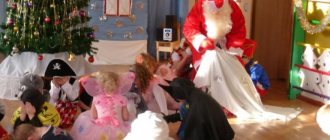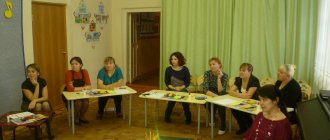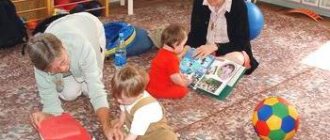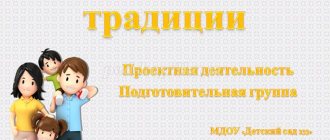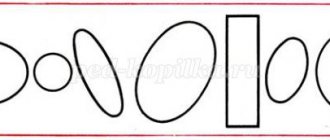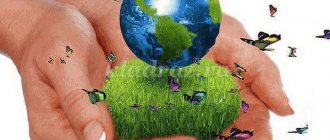Mathematical leisure in the preparatory group of kindergarten
Entertaining leisure time in mathematics based on the Russian folk tale “Turnip”.
Preparatory group Age group: preparatory group Purpose : To maintain interest in mathematics. Consolidate the knowledge acquired in class. Integration of educational areas : cognitive (FEMP), social-communicative, physical. Program tasks: Educational:
Continue to consolidate the solution of arithmetic problems and write them using numbers;
knowledge of geometric shapes, ability to name the composition of numbers; compare numbers using the definitions greater than, less than, equal to. Practice decomposing numbers into tens and ones. Consolidate Developmental tasks
: Develop logical thinking, imagination, memory, attention.
Contribute to the formation of mental operations, speech development, and the ability to give reasons for one’s statements. Educational objectives
: To develop independence, the ability to understand an educational task and carry it out independently.
Cultivate interest in mathematical studies. Develop a desire to help others in difficult times. Ways to organize children: in a semicircle, in a circle, sitting at tables, standing, moving around the group. Material : Slides with images of fairy-tale characters, number series, simple pencils, spreads with numbers and signs, counting sticks. Preliminary work: prepare demonstration and handout material, create a presentation.
GCD move:
All the children gathered in a circle, I am your friend and you are my friend.
Let's hold hands tightly and smile at each other! Guys, today we are going on a journey through a fairy tale, but what kind of fairy tale it is you will have to guess for yourself. I offer you parts of the pictures. You will collect the whole ones and from them you will find out what kind of fairy tale it is. Task No. 1: D/i “Assemble a picture”: The teacher invites children to the tables on which parts of cut pictures lie (the pictures are the same for all, and each child has his own geometric figure in the lower right corner). Children sit at tables and collect pictures. What fairy tale did the heroes come from? Children's answers
Correct, this is the Russian folk tale “Turnip” (Slide No. 1). To start the journey, we need to remember how fairy tales begin.
We remember: “Once upon a time,” “In a certain kingdom, in a certain state,” “Beyond the mountains, beyond the forests, beyond the wide seas.” So we found ourselves in a fairy tale... (Slide No. 2) - Grandfather “Grandfather planted a turnip. But no, I haven’t planted it yet. What happened interesting? Grandfather doesn’t know when to plant turnips, shall we help him? Task No. 2: Questions from Grandfather: At what time of year should Grandfather plant turnips? What about harvesting? How many months are there in a year? How many days are there in a week? Name Tuesday's neighbors. How many nuts are there in an empty glass? If you eat one plum, what remains? Who has more paws: a hare or a bunny? How many paws do two dogs have? How many ears do two mice have? Finally, Grandfather planted a turnip. The turnip grew large, very large, weighing more than 5 kilograms, but less than 7 (Slide No. 3). How many kilograms does a turnip weigh? Children's answers Grandfather went to pull a turnip. He pulls and pulls, but cannot pull it out (Slide No. 4). He started calling Grandma. But Grandma doesn’t hear, she’s busy with work. I was washing the plates, but I got them mixed up... He can’t figure out who’s who. Task No. 3 : Guys, please help the fairy tale heroes find their plate. You need to connect the fairy tale hero with his plate with an arrow (Slide No. 5). The grandfather’s plate is large and round, the grandmother’s is square, the granddaughter’s is a plate with flowers, the Bug’s is neither square nor round, the cat’s is oval, the mouse’s is small and round. The teacher invites the children to the tables on which there are album sheets with assignments and pencils. Children complete the task. If desired, one of the children voices the solution. Grandma came (Slide No. 6). Grandma for Grandfather, Grandfather for the turnip, they pull, they pull, they can’t pull it out! They began to call their granddaughter, and in the morning she ran to the river to fish. She really loves this activity. Task No. 4: Let's help our Granddaughter as soon as possible and catch a fish each. Children play the game "Fishing". Each fish has a task that needs to be completed. 1. Compare the numbers 6 and 9 2. How many tens and ones are in the number 16 3. Tell the composition of the number 5 4. Name a number in which there is 1 ten and 2 ones. 5. Name the neighbors of the number 15. 6. What geometric shapes are used to make up the picture of the animal? 7. Count from 13 to 0 8. Compare the numbers 4 and 4 9. How many tens and ones are in the number 6 The granddaughter came running to the call and began to help (Slide No. 7). Granddaughter for Grandmother, Grandmother for Grandfather, Grandfather for the turnip, they pull and pull, but they cannot pull it out. Then they began to call Zhuchka. And Zhuchka is not a simple dog, but a learned one. She doesn’t hear, she’s busy with her own thoughts, solving problems. Task No. 5 “Solve the problem”: Let us solve these problems too. 1. Five puppies Plus mother - husky. How much will it be? (6) (Slide No. 7). 2. 8 sparrows were sitting on a branch, 3 of them flew away. How many sparrows are left on the branch? (Slide No. 8). A bug came running (Slide No. 9). A bug for a granddaughter, a granddaughter for a grandmother, a grandmother for a grandfather, a grandfather for a turnip. They pull and pull, but they can’t pull it out. They began to call the Cat. And Koshka dreams of performing with Kuklachev, look at the warm-up she came up with. Children do warm-up. The cat played with its tail - That's it! Like this! She rolled the ball on the floor - That's it! That's it! And she jumped around the room - That's it! Like this! And then the cat got tired and cried a little. 1,2,3,4,5 – Let’s console the cat. The Cat came running (Slide No. 9). Cat for Bug, Bug for granddaughter, granddaughter for Grandma, Grandma for Grandfather, Grandfather for the turnip. They pull and pull, but they can’t pull it out. They began to call Mouse. The mouse ran, waved its tail and broke all the geometric shapes. Shall we help her? Shall we add the figures? Task No. 6: The teacher invites children to the tables on which counting sticks lie. Children perform tasks under the dictation of the teacher. 1. Build a figure from three sticks. What happened? (triangle). 2. Place 2 sticks on it to make 2 triangles. What kind of figure did you get? (rhombus). 3. Construct a figure with 2 long sides and 2 short sides (rectangle). 4. Now take 1 stick and divide the rectangle into 2 identical shapes. What did you get? The Mouse came running (Slide No. 11). Mouse for Cat, Cat for Bug, Bug for granddaughter, granddaughter for Grandmother, Grandmother for Grandfather, Grandfather for a turnip. They pull, pull, pull, pull and... they pulled out the turnip!!! This is how our fairy tale turned out, if it weren’t for your knowledge and help, Grandfather wouldn’t have been able to cope with the turnip alone! Now we need to return to the group, and for this we need to complete the last task. Task No. 7: Game “Who can move objects faster.” In the center of the hall there is a table on which objects of various shapes are laid out: • a scarf, a flag, a triangle, a pioneer tie;
• notebook, book, album, toy wooden bed; • plate, record, ring, tambourine. At a distance of 2-3 m from the table there are 3 chairs, cards with these geometric shapes (circle, rectangle and triangle) are attached to their backs. Children are divided into 3 teams (according to the shapes that were in the cut pictures). At the signal of the leader, the children they run to the table, select an object that matches the shape of “their” geometric figure and transfer it to their chair. Then they run for the second item. (Only one item can be taken at each approach). The winner is the team that moves all the items first. Self-esteem: Well, my young mathematicians, did you enjoy your journey into a fairy tale? Now I want to ask you to think and evaluate how well you did today. Yellow smiley - I'm happy with my success. Green smiley - I worked hard, but I didn’t complete all the tasks. Red smiley - did not complete a single task. Presentation on the topic: Entertaining leisure time in mathematics based on the Russian folk tale “Turnip”
We recommend watching:
Lesson notes on FEMP for the preparatory group. Solving GCD problems in mathematics in a preparatory group in kindergarten Synopsis of a game GCD in mathematics for children of the preparatory group of a preschool educational institution Synopsis of an integrated GCD for FEMP for a preparatory group for the Federal State Educational Standard
Similar articles:
Summary of a mathematics lesson in the preparatory group of a preschool educational institution on the topic: Hexagon
Abstract of GCD in mathematics in the preparatory group. Composition of number 5
Abstract of GCD in mathematics in the preparatory group. Converting Shapes
Abstract of GCD in mathematics in the preparatory group on the topic: Counting forward and backward
Summary of a mathematics lesson in the preparatory group of a preschool educational institution on the topic: Composition of the number 10
MAGAZINE Preschooler.RF
Mathematical entertainment in the preparatory group Program content: Consolidate acquired data, skills and abilities. Promote the development of cognitive activity, contribute to the formation of the child’s moral and strong-willed personality. Arouse positive emotions in children and develop aesthetic feelings. Course of the lesson: Design: images of labyrinths, geometric figures, tables with tasks. The tables are arranged to form the “bow of a ship”, with a mast with a flag and a steering wheel in the center. Educator: Guys, today I invite you on a journey through the country of “Mathematics”. This country consists of small islands, each of which is inhabited by fabulous wizard residents. They love to ask their guests riddles and ask questions. This journey will be very interesting for you. But what will we use to hit the road? In front of you are pieces of paper with dots and numbers drawn on them; connect all the dots in order. What did you get? Children: ship. Educator: That's right, ship. On this ship you and I will sail to the country of “Mathematics”. A child stands at the mast with a flag, wearing a cap and a sailor’s collar. Teacher (captain): Raise the flag! Sailor: Yes, raise the flag! Comrade captain, the ship is ready to sail. Captain: Raise anchor! Sailor: Yes, raise anchor! Captain: Full speed ahead! Sailor: Yes, full speed ahead! Captain; To get to the island, you need to solve problems: There are 4 corners in the room. There is a cat in every corner. Three cats sit opposite each cat. How many cats are there in total? The animal has 2 right legs, 2 left legs, 2 legs in front, 1 in the back. How many legs does an animal have? Captain: We sailed to the island of “Riddles”. Wizard's voice: Hello, guys! I am a wizard, the owner of the island “Riddles”, I greet you. Welcome to my territory. There are flowers on the board, riddles are written on the petals. A cat is dancing, but only one leg. (Yula) Two brothers live across the road, but they don’t see each other. (Eyes) I stand on four legs, I can’t walk at all You will rest on me When you get tired of standing (Chair) 4. Two sisters, two weaves Made of sheep’s wool thin How to go for a walk - put them on, So as not to freeze five and five (Mittens). Captain: Well done, guys! You have solved the riddles. Now answer the questions of the wizard of the island “Riddles”. How many suns are there in the sky? How many eyes does an owl have? How many fingers does a glove have? How many lights does a traffic light have?How many wheels does the car have?
Physical education minute: 1,2,3,4,5 - stomp our feet
Now let's move on. You and I have sailed to the island “Geometric Shapes”.
Wizard's voice: Hello, guys! The owner of the island “Geometric Shapes” is speaking to you. You can get to my island if you complete the tasks.
What are the figures here? (a set of geometric shapes on the board). How many are there?
How many sticks do you need to make a five-pointed star? (Ten). Make a star. Take 10 sticks and make any shape you want.
Arrange 2 sticks so that out of 4 squares you get 5.
Wizard's voice: Well done, guys! You completed my tasks correctly..Welcome to the island “Geometric Shapes”.
Didactic game “Which figure is hidden?”
Children are offered figures of different colors, one figure is removed. Children must determine which figure is gone.
Captain: It's time for us to set sail. Our path lies to the island "Labyrinth"
Children are offered several mazes on the theme “Let’s help a girl, kitten, etc., who got lost, get out of the maze.”
Physical education lesson: The wind is blowing in our faces
Captain: It's time for us to leave the Labyrinth Island and return to the kindergarten. Raise anchor!
Sailor: Yes, raise anchor!
Captain: Full speed ahead!
Sailor: Yes, full speed ahead!
Music is playing.
Captain: Here, guys, we have returned to our kindergarten from a trip to the country “MATH.” I think we will visit this wonderful country more than once. After such a journey, it would not hurt to refresh yourself (treats are distributed to the children).
The lesson is over.
| Next > |

